Amy Russart
Amy's Care Team Helps Her Regain Independence and Appreciate the Small Stuff

Experiencing the “I wish I’d done this sooner” revelation usually occurs after you pick up a habit that betters your life, like developing healthier eating habits (and lowering your cholesterol or losing weight); but, wishing you’d gotten a leg amputation earlier? Who longs for that?
Amy Russart, 48, still regrets waiting. “As soon as I got the amputation and the prosthesis, it opened up a whole new world. I don’t look back too much, but I remember thinking: Shoot. I should’ve done this months ago,” she recalls.
An Unfortunate Chain of Events
In 2013, Amy developed a bone infection, called charcot foot, in her right ankle. Charcot foot is a condition that causes weakening of the bones in the foot, which can occur in people who have significant nerve damage (neropathy), prevalent among diabetics, like Amy.
Amy had surgery to remove some of the bones in the infected area in August 2013, and while the infection healed as expected, her right foot essentially became useless. So after talking with her doctor and experiencing some internal debate, Amy decided to move forward with a leg amputation, from her right knee down, on March 17, 2014 at Good Samaritan Hospital.
Amy spent five days in the acute care unit and then moved to the rehabilitation and physical therapy unit, where she stayed for nearly three weeks. When asked to describe her experience in both units, Amy exclaims, without hesitation, “absolutely incredible!”
In fact, it’s her positive outlook on the situation – and life, in general – that’s helped Amy make so much progress in terms of regaining her independence. Around the time Amy developed the bone infection in her foot, she was faced with another stressor: She’d developed double wrist drop, or radial nerve palsy, an issue whereby a person cannot extend his or her wrist and the hand hangs flaccidly. “They were just flopping hands. They were useless,” Amy recalls.
Then, something else happened.
They say bad things happen in threes, and just a few days before heading into surgery for her amputation, Amy experienced this adage firsthand; she went into renal failure and needed to go on kidney dialysis. “Unfortunately, I had the perfect storm of events,” Amy jokes.
Making the Most of Physical and Ouccupational Therapy
The day after Amy was admitted into the rehabilitation unit, she started three-hour rehabilitation sessions, which included physical and occupational therapy, so she could regain mobility and relearn how to perform activities of daily living, like showering and doing household chores. Her therapy sessions were five days a week and then she performed exercises – prescribed by her therapists – on her own during the weekend. She appreciated how much the staff pushed her toward her goals, and says that her care team helped her maintain enthusiasm, especially on days when she'd feel down about the situation, which, fortunately, were rare.
"I wish I could convey how much the staff – every single person I came across – with all of this, has just been unbelievable. I go to OT (occupational therapy) and maybe I have this cranky morning, but then I leave there and I’m so energized." Amy says, reflecting on her experience. “I set small goals and they were right alongside of me. They were incredible.”
After spending nearly a month in inpatient rehabilitation, Amy moved to a nearby retirement facility for a couple months so she’d continue having round-the-clock access to care, because unfortunately, her double wrist drop still hadn’t improved to the point where she could perform dialysis on her own.
She admits, however, that by the time she left Good Samaritan, she felt comfortable with where she was in terms of her progress. “Good Sam laid a serious and amazing foundation,” Amy points out.
Moving Forward and Looking Ahead
Once Amy left the retirement home, she started occupational and physical therapy on an outpatient basis and has improved dramatically since then. Now, she’s back at home and living an independent life, even performing dialysis four times a day on her own. From being able to perform simple activities, like having enough control in her hands to make a “thumbs up,” to having the ability to drive a car (with no modifications), she feels grateful – every day – for the progress she’s made.
She’s especially thrilled to travel south for Thanksgiving to visit her parents in Hilton Head. It’s the first time in years she’ll be taking a vacation. “I’m going to be able to walk onto that airplane and walk right off! It’s the little things,” Amy says.
And, while she’s not one to spend much time dwelling on the past, she says she’ll never forget the care team she had at Good Samaritan. “All the people I’ve met throughout this journey, they will forever be in my heart and in my life."